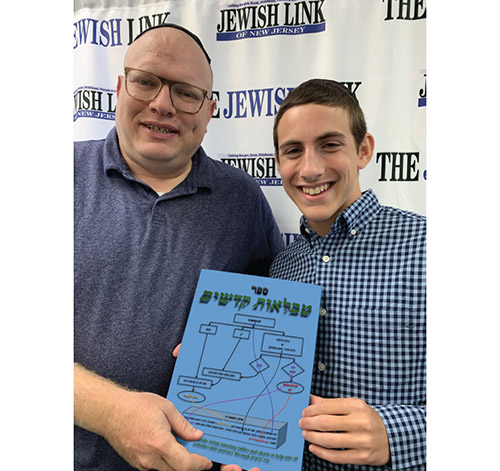

Bergenfield’s Yehuda Weiss, a graduate of Rosenbaum Yeshiva of North Jersey who is about to begin ninth grade at Heichal HaTorah, has spent an incredible amount of time learning Mishnah over the past few years.
So much so, that at 14 years old, he has just now published his first-ever sefer.
“I found that to better understand the Mishnayos, it was helpful to organize (them) using charts and diagrams. I thought that perhaps other people who are learning Mishnayos Kodshim would find my notes helpful,” wrote Yehuda in the sefer’s introduction.
The sefer, a 224-page-book called “Tavlaot Kodshim,” is a full-color guide to Seder Kodshim, often known as one of the most difficult-to-understand Sedorim (or “orders”) of the six books that comprise the Mishnah. Written in Roman times by Rav Yehudah Ha-Nasi, the Mishnah is the authoritative collection of critical text embodying Torah She’Ba’al Peh, the Oral Torah. The Mishnah forms the first part of the Talmud (Gemara), and the entire rest of the Gemara is comprised of discussions and expoundings on the text of the Mishnah.
The sefer is enthusiastically endorsed with glowing haskomot, letters of accolade, by Rabbi Hershel Schachter (Yehuda’s father, Rabbi Duvie Weiss, is a talmid of Rav Schachter) and Rabbi Yaakov Neuburger of Yeshiva University/RIETS, the latter of whom is also Yehuda’s congregational rabbi at Bergenfield’s Congregation Beth Abraham, as well as Yehuda’s own rabbeim at RYNJ, Rabbi Avi Bernstein and Rabbi Yehuda Kopstick.
“Yehuda’s accomplishment at such a young age promises that we are watching the emergence of one of the Torah leaders of the next generation,” Rabbi Neuburger told The Jewish Link. “And when our children will read, with seasoned skepticism, that Harav Yehuda Weiss Shlita wrote a sefer on Kodshim as a child, we will wholeheartedly verify and humbly submit that it can be done.
“What a home, what a yeshiva, ketana, middle and high school, what a kehilla that can nurture this passion to study Torah, this excitement and this skill set to teach Torah and this steadfastness to complete a large and difficult section of it. May this holy partnership continue to receive Hashem’s guidance and blessings to have this kind of nachas come ever increasingly,” added Rabbi Neuburger.
“This sefer of intricate charts and tables has been compiled in a most ingenious and systematic fashion that will help countless people understand the complexities of the two most difficult Sedarim,” Rabbi Bernstein told The Jewish Link. “Yehuda Weiss, a most outstanding student in both depth of knowledge and exceptional middos, has blessed us with this magnificent sefer, and in turn should be infinitely blessed for his hard work and steadfast dedication to and diligence in Torah learning.”
Rabbi Bernstein expressed his pride in the work that Yehuda has created as well as his intellectual growth and Torah understanding. “Over the last few years, I have seen Yehuda’s growth in learning and increasingly unparalleled drive. While some can boast cognitive ability and others a sterling character, Yehuda can claim both, but never would. His humility and unassuming nature, along with his remarkable eye for detail and unyielding determination, have all contributed to this accomplishment. I am exceedingly proud of Yehuda and this accomplishment, and look forward to similar achievements in the future. He is not simply a rising star; he is already shining quite bright at such a young age,” said Bernstein.
Mishnah study in yeshiva day schools can begin as early as second or third grade in the more Haredi schools, but more commonly in fourth or fifth grade, while many students begin studying Gemara in middle school. Mishnayot are also studied through the middle school years.
The book is a visual text of all the individual perakim, Yehuda told The Jewish Link, and he explained that it was developed out of his perspective as a visual learner and his interest in breaking down texts visually in order to understand them better. In addition to diagrams, he also creates tables to organize information. He utilizes different colors to denote different kinds of information contained inside the text, such as blue for kosher (or tahor), orange for something that is allowable, or red for something that is not allowable (pasul, or assur). Purple is used to indicate names.
Classroom reference copies of Sefer Tavlaot Kodshim have already been sold to Yeshivat Noam and Yavneh Academy. Rabbi Yitzchok Motechin of Yeshivat Noam, who purchased the books for his school, told The Jewish Link he was “wowed” when he saw the book for the first time, and that his wife, who saw it first, brought it to him, saying that he just had to see it. While he said the sefer was a tremendous accomplishment for both Yehuda and for his rebbeim for inspiring him toward its creation, he also added the following: “The main lesson from Yehuda’s sefer is that we have to think differently about what we can do as educators and what our students can do,” he explained. “I wanted to show it to teachers and students so they can see what an inspired student who has a curiosity to learn could accomplish.”
“I will be showing it to our teachers and brainstorming about what to do with it and I will also show it to our students. The same way that he took the opportunity, I would like our students to pursue and take opportunities in things that they are interested in.”
The book is currently available in Judaica House and Weinreb’s in Teaneck, and will soon be distributed at other local Jewish bookstores. It is also available online (https://tinyurl.com/y5nq5tr6). Those interested in bulk purchases or who would like to purchase it directly from Yehuda may contact yehudaweiss4@gmail.com.










